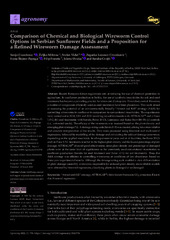Приказ основних података о документу
Comparison of chemical and biological wireworm control options in Serbian sunflower fields and a proposition for a refined wireworm damage assessment
| dc.creator | Gvozdenac, Sonja | |
| dc.creator | Milovac, Željko | |
| dc.creator | Vidal, Stefan | |
| dc.creator | Lozanov Crvenković, Zagorka | |
| dc.creator | Štajner Papuga, Ivana | |
| dc.creator | Franeta, Filip | |
| dc.creator | Ovuka, Jelena | |
| dc.creator | Cvejić, Sandra | |
| dc.date.accessioned | 2022-04-13T10:08:43Z | |
| dc.date.available | 2022-04-13T10:08:43Z | |
| dc.date.issued | 2022 | |
| dc.identifier.issn | 2073-4395 | |
| dc.identifier.uri | http://fiver.ifvcns.rs/handle/123456789/2595 | |
| dc.description.abstract | Recent European Union regulations aim at reducing the use of chemical pesticides in agriculture. In sunflower production in Serbia, the use of synthetic insecticides for soil and seed treatments has become a prevailing practice for wireworm (Coleoptera: Elateridae) control. However, a number of compounds efficiently used as seed treatments have been phased out. This work aimed at assessing the potential of an environmentally friendly “Attract and Kill” strategy (A&K) for controlling wireworms in sunflower in comparison to conventional insecticides. The experiments were carried out in 2018, 2019 and 2021 involving (a) soil treatments with ATTRACAP® and a Force 1.5 G; (b) seed treatments with Sonido, Force 20 CS, Lumiposa and Buteo Start 480 FS; (c) controls (i.e., untreated seeds). The efficacy of the treatments was assessed based on the plant density and emerging plant damage (%). A damage rating scale (levels 0–5) was created, aiming for a more reliable and concrete interpretation of the results. Data were processed using binomial and multinomial regressions, followed by modelling of the damage and calculating the odds of damage occurrence, depending on the applied insecticide. In all experimental years and at all localities, the Force 20 CS and/or Force 1.5 G treatments resulted in the highest plant density and the lowest percentage of plant damage. ATTRACAP® showed good effectiveness, since plant density and percentage of damaged plants were at the same level of significance as the commonly used conventional insecticides in sunflower production (Sonido for seed treatment and Force 1.5 G for soil treatment). Thus, the A&K strategy was efficient in controlling wireworms at conditions of low abundance, based on three-year experimental results. Although the damage rating scale enabled a clear differentiation of plant damage caused by wireworms responsible for reduced plant density, more reliable models were obtained by binomial regressions, classifying plants as damaged or undamaged. | sr |
| dc.language.iso | en | sr |
| dc.publisher | Basel : MDPI | sr |
| dc.relation | info:eu-repo/grantAgreement/MESTD/inst-2020/200032/RS// | sr |
| dc.relation | info:eu-repo/grantAgreement/MESTD/inst-2020/200125/RS// | sr |
| dc.rights | openAccess | sr |
| dc.rights.uri | https://creativecommons.org/licenses/by/4.0/ | |
| dc.source | Agronomy-Basel | sr |
| dc.subject | “Attract and Kill” strategy | sr |
| dc.subject | ATTRACAP® | sr |
| dc.subject | Metarhizium brunneum | sr |
| dc.subject | CO2 attraction | sr |
| dc.subject | Elateridae | sr |
| dc.subject | binomial regression | sr |
| dc.title | Comparison of chemical and biological wireworm control options in Serbian sunflower fields and a proposition for a refined wireworm damage assessment | sr |
| dc.type | article | sr |
| dc.rights.license | BY | sr |
| dc.citation.issue | 12 | |
| dc.citation.rank | M21 | |
| dc.citation.spage | 758 | |
| dc.identifier.doi | 10.3390/agronomy12040758 | |
| dc.identifier.fulltext | http://fiver.ifvcns.rs/bitstream/id/7160/agronomy-12-00758.pdf | |
| dc.identifier.scopus | 2-s2.0-85127712170 | |
| dc.identifier.wos | 00078674600000 | |
| dc.type.version | publishedVersion | sr |


